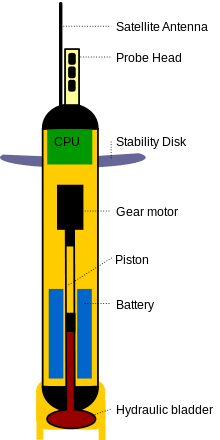Float (oceanographic instrument platform)

A float (not to be confused with a drifter) is an oceanographic instrument platform used for making subsurface measurements in the ocean.[1] Common sensors carried by floats include temperature, conductivity, and pressure (from which salinity can be calculated), and, for acoustically tracked floats, a hydrophone, though a wide range of other sensors have been deployed on floats as well. Often, floats are treated as disposable, as the expense of recovering them from remote areas of the ocean is prohibitive; when the batteries fail, a float ceases to function, and drifts at depth until it runs aground or floods and sinks. In other cases, floats are deployed for a short time and recovered.
Profiling floats
Profiling floats, such as APEX floats, SOLO floats (including SOLO-TREC), PROVOR floats, and Navis floats, change their buoyancy in order to move vertically in the ocean repeatedly collecting data that spans a range of depths ("profiles").[2] These autonomous drifting vehicles typically have aluminum pressure cases on the order of one meter long, use a pump to inflate an external oil bladder to increase buoyancy, are capable of making a few hundred profiles to a maximum depth of 2000 meters before battery exhaustion, and transmit their data to shore via satellite communication; they weigh approximately 20 kg, and cost about $25,000 US without sensors. Deeper diving models that can reach 6000 meters have been made,[3] deep enough to reach the ocean floor in most locations. A major user of profiling floats is the Argo program, which aims to keep 3000 of them functioning in the ocean at any given time.
Non-profiling floats
Some floats are designed only to map currents at a single depth; they don't have the ability to adjust their buoyancy, so are carefully ballasted to match the water density at the desired depth. A modern example of this type is the RAFOS float; historical versions include Swallow, ALACE, and SOFAR floats.